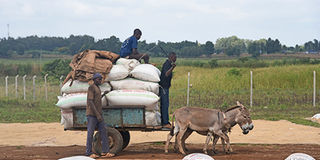Agronomist notebook: Understanding fertiliser use for the best results

Farmers transport fertiliser in a donkey-drawn cart in Mwea, Kirinyaga County. The optimum timing of fertiliser application is determined by the nutrient uptake pattern of the crop involved. PHOTO | FILE | NATION MEDIA GROUP
What you need to know:
- For best results, you need to consider the above factors and apply the fertilisers in the right proportions and methods to increase efficiency.
- The mineral does not easily leach hence the placement method is the most suitable during application. Also, the use of excess nitrogen creates tall, skinny stems that are too weeks to hold themselves.
- For maximum nutrient uptake by the plant, split the fertiliser application. If applying CAN in vegetables, top-dress at week four and consequently at week six.
- It’s thus important for farmers to do a soil test to determine the nutrients available in the soil and what the plants require.
The other day in one of the farmer WhatsApp groups I belong to, a member asked the best fertiliser he can apply on his maize and beans for top dressing.
As is the norm in such groups, ordinary members are usually the first to respond. Some advised the farmer to purchase any fertiliser as they all work the same while others suggested animal manure.
Well, this made me realise that most farmers just apply fertilisers on their crops without doing a soil analysis test, considering the type of crop planted, stage of the crop and amount to apply among other factors.
For best results, you need to consider the above factors and apply the fertilisers in the right proportions and methods to increase efficiency.
The 4Rs concept is the best approach to use when applying fertiliser for greater efficiency. The Rs stand for the right source, right rate, right time and right fertiliser as required by the crop.
For the right source, match the fertiliser type with the needs of the crop. For example, during planting, the crop requires more phosphorus for root development.
The mineral does not easily leach hence the placement method is the most suitable during application. Also, the use of excess nitrogen creates tall, skinny stems that are too weeks to hold themselves.
In some vegetable and fruits, it results in too much vegetative growth with little yields. It’s thus vital to read the fertiliser label carefully to understand the nutrients available before starting application.
Apply the fertiliser at the right time, that is, when the crop requires them. The decision should be based on the consideration of crop uptake, soil supply, nutrient loss risks and field operation.
For instance, avoid using nitrogen, available in CAN and urea fertilisers, during planting as it is highly soluble hence easily leached in the soil.
For maximum nutrient uptake by the plant, split the fertiliser application. If applying CAN in vegetables, top-dress at week four and consequently at week six.
Split fertiliser application helps to avoid salts damaging the crop and improves the plant uptake rates. Also, applying smaller amounts of fertilisers at shorter intervals reduces salt stress.
OPTIMUM TIMING
The optimum timing of fertiliser application is determined by the nutrient uptake pattern of the crop.
Wrong timing results in nutrient loss, fertiliser wastage and crops and environmental damage.
The quantities of nutrients applied to the crop depend on the requirements and soil fertility. For instance, if required to put 10 grammes per metre square, ensure you do not exceed or it’s less.
Applying excess fertiliser results in loss as the plants cannot absorb all of it.
It’s thus important for farmers to do a soil test to determine the nutrients available in the soil and what the plants require.
Put the fertiliser in the right place, in case of foliar, apply on the leaves and not in the soil. Avoid putting too much nitrogenous fertilisers on the leaves as they will scorch them.
Apply fertiliser when the soil is sufficiently wet to help immobilise the nutrients for uptake and prevent surface runoff.
The soil type affects the timing and frequency of fertiliser application. Cation Exchange Capacity (CEC) measures the ability of the soil to hold and store positively-charged elements, such as calcium.
Soils with high CEC require a lower frequency of fertiliser application, therefore, higher rates are applied with each application. It’s necessary to split the fertiliser application in soils with low CEC to prevent nutrients loss.
The texture of the soil determines the timing and frequency, for instance, sandy soils usually have a low CEC, while clayey soils have a higher CEC.
Soils with fine texture hold more water compared to sandy soils. Irrigation frequency is usually higher in sandy soils and, as a result, leaching of nutrients is higher. It’s therefore, important to split fertiliser application in sandy soils.





